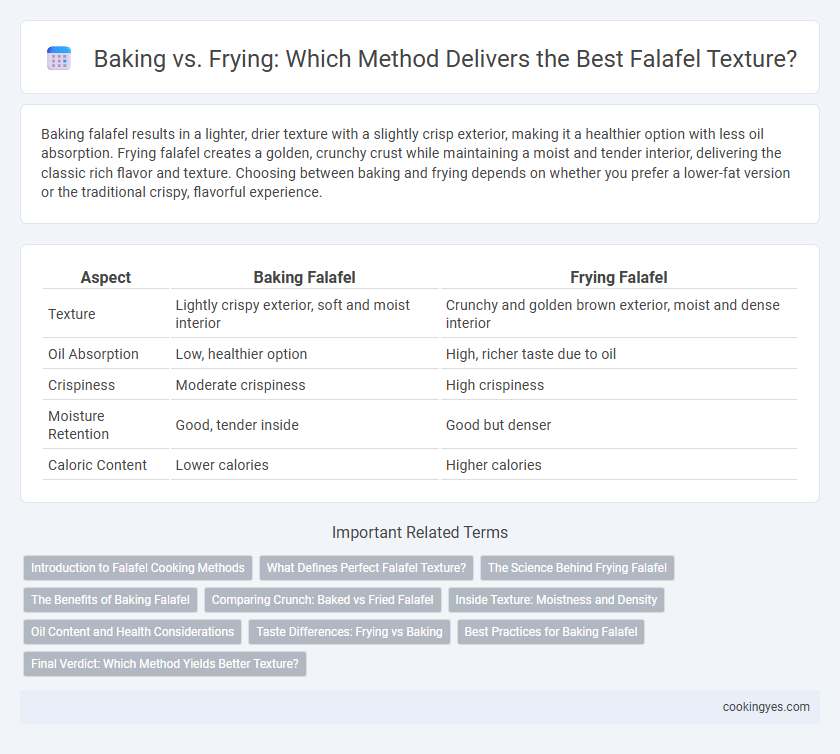Baking falafel results in a lighter, drier texture with a slightly crisp exterior, making it a healthier option with less oil absorption. Frying falafel creates a golden, crunchy crust while maintaining a moist and tender interior, delivering the classic rich flavor and texture. Choosing between baking and frying depends on whether you prefer a lower-fat version or the traditional crispy, flavorful experience.
Table of Comparison
| Aspect | Baking Falafel | Frying Falafel |
|---|---|---|
| Texture | Lightly crispy exterior, soft and moist interior | Crunchy and golden brown exterior, moist and dense interior |
| Oil Absorption | Low, healthier option | High, richer taste due to oil |
| Crispiness | Moderate crispiness | High crispiness |
| Moisture Retention | Good, tender inside | Good but denser |
| Caloric Content | Lower calories | Higher calories |
Introduction to Falafel Cooking Methods
Baking falafel results in a lighter, less oily texture with a slightly drier crumb, while frying produces a crispy, golden-brown exterior and moist interior due to rapid oil absorption. Traditional Middle Eastern recipes favor frying for its rich flavor and crunchy texture, whereas baked falafel offers a healthier alternative by reducing fat content. Understanding these cooking methods helps tailor falafel preparation to desired taste and dietary preferences.
What Defines Perfect Falafel Texture?
Perfect falafel texture is defined by a crispy exterior and a moist, tender interior, where baking produces a lighter, less oily crust while frying delivers a rich, golden-brown crunch. Baking falafel reduces oil absorption, resulting in a drier, denser bite that highlights chickpea flavor, whereas frying rapidly seals the surface, preserving moisture and creating a satisfying contrast. Texture preference depends on desired oil content and crispiness, with frying favored for traditional crunch and baking suited for healthier, crisp but less greasy falafel.
The Science Behind Frying Falafel
Frying falafel creates a crispy, golden exterior due to the Maillard reaction, where high heat causes amino acids and sugars to bond, enhancing flavor and texture. The intense heat of oil rapidly dehydrates the falafel's surface, forming a crunchy crust while keeping the interior moist and tender. This contrast is difficult to achieve with baking, as the lower temperature and dry heat do not promote the same chemical reactions or rapid crust formation.
The Benefits of Baking Falafel
Baking falafel results in a significantly lower oil absorption, making the texture lighter and less greasy compared to frying. The dry heat of baking ensures a crisp outer layer while maintaining a tender, moist interior, enhancing overall flavor without compromising health. This method preserves the nutritional value of chickpeas by reducing oil content and producing fewer harmful acrylamides commonly found in fried foods.
Comparing Crunch: Baked vs Fried Falafel
Baked falafel offers a slightly drier, less oily crunch while maintaining a tender interior, making it a healthier option with moderate crispness. Fried falafel achieves a deep golden, uniformly crispy exterior due to direct oil immersion, resulting in a more intense crunch and richer mouthfeel. Texture preference depends on balancing health considerations with the desired crispy intensity in falafel preparation.
Inside Texture: Moistness and Density
Baking falafel results in a slightly drier and denser inside texture compared to frying, which produces a moist and tender interior due to the rapid cooking process. The frying method retains more moisture within the falafel, creating a juicy and fluffy bite, while baking often yields a firmer and more compact crumb. Choosing frying enhances the moistness and lightness of the falafel center, whereas baking prioritizes a less oily and more uniform texture.
Oil Content and Health Considerations
Baking falafel significantly reduces oil content compared to frying, resulting in a lower calorie and fat intake while maintaining a crisp exterior. Frying falafel in oil creates a rich, crunchy texture but increases saturated fat levels, which can impact heart health if consumed frequently. For a healthier alternative, baking offers a balanced texture with less oil absorption, supporting better nutrition without sacrificing flavor.
Taste Differences: Frying vs Baking
Frying falafel produces a crispy, golden exterior with a moist, tender inside, enhancing its traditional rich, nutty flavor through caramelization and Maillard reactions. Baking falafel results in a lighter, less oily texture with a slightly drier interior, preserving more of the chickpea's natural earthiness but offering less crunch and depth of flavor compared to frying. Taste differences are pronounced: fried falafel delivers a robust, savory intensity, while baked falafel provides a milder, subtler profile ideal for health-conscious consumers.
Best Practices for Baking Falafel
Baking falafel offers a healthier alternative to frying by reducing oil absorption while maintaining a crisp exterior when baked at 375degF for 20-25 minutes, flipping halfway through. To achieve optimal texture, preheat the oven and use a lightly oiled baking sheet or parchment paper to prevent sticking and promote even browning. Incorporating a small amount of olive oil into the falafel mixture can enhance moisture retention and prevent dryness during baking.
Final Verdict: Which Method Yields Better Texture?
Frying falafel produces a crispy, golden exterior with a moist, tender interior, creating the classic texture most consumers prefer. Baking results in a slightly drier and less crisp falafel, though it is healthier due to reduced oil content. For optimal texture, frying remains the superior method, delivering the authentic balance of crunch and softness that defines traditional falafel.
Baking vs Frying for Falafel Texture Infographic

 cookingyes.com
cookingyes.com